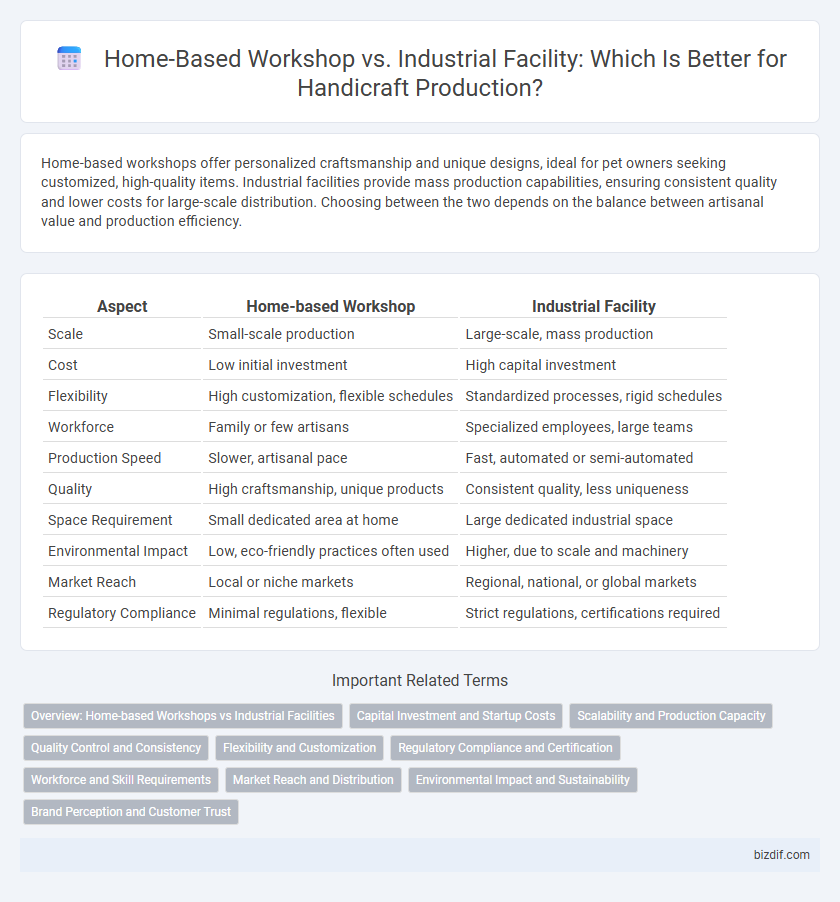Home-based workshops offer personalized craftsmanship and unique designs, ideal for pet owners seeking customized, high-quality items. Industrial facilities provide mass production capabilities, ensuring consistent quality and lower costs for large-scale distribution. Choosing between the two depends on the balance between artisanal value and production efficiency.
Table of Comparison
| Aspect | Home-based Workshop | Industrial Facility |
|---|---|---|
| Scale | Small-scale production | Large-scale, mass production |
| Cost | Low initial investment | High capital investment |
| Flexibility | High customization, flexible schedules | Standardized processes, rigid schedules |
| Workforce | Family or few artisans | Specialized employees, large teams |
| Production Speed | Slower, artisanal pace | Fast, automated or semi-automated |
| Quality | High craftsmanship, unique products | Consistent quality, less uniqueness |
| Space Requirement | Small dedicated area at home | Large dedicated industrial space |
| Environmental Impact | Low, eco-friendly practices often used | Higher, due to scale and machinery |
| Market Reach | Local or niche markets | Regional, national, or global markets |
| Regulatory Compliance | Minimal regulations, flexible | Strict regulations, certifications required |
Overview: Home-based Workshops vs Industrial Facilities
Home-based workshops in handicraft emphasize personalized, small-scale production with artisans often managing every stage, fostering unique and customized creations. Industrial facilities prioritize high-volume output using mechanized processes, maximizing efficiency and consistency in product quality. The choice between the two impacts cost structures, production speed, and the level of craft authenticity perceived by consumers.
Capital Investment and Startup Costs
Home-based workshops typically require minimal capital investment, leveraging existing spaces with low startup costs, making them accessible for artisans and small-scale producers. Industrial facilities demand substantial financial resources for machinery, factory setup, and compliance with regulatory standards, resulting in significantly higher startup expenses. The scale and complexity of operations in industrial settings drive capital intensity compared to the flexible, cost-efficient nature of home-based handicraft production.
Scalability and Production Capacity
Home-based workshops offer limited scalability and production capacity due to space constraints and reliance on manual labor, making them ideal for small-batch, customized handicrafts. Industrial facilities provide significantly higher scalability with access to automated machinery, larger workforce, and streamlined processes, enabling mass production and consistent output. The choice between a home-based workshop and an industrial facility hinges on the desired production volume and market reach within the handicraft sector.
Quality Control and Consistency
Home-based workshops excel in personalized quality control, allowing artisans to meticulously inspect each product for unique details and craftsmanship. Industrial facilities implement standardized processes and automated systems to ensure consistent output and uniformity across large production volumes. Balancing artisanal attention with industrial precision enhances overall product reliability and consumer satisfaction in handicraft manufacturing.
Flexibility and Customization
Home-based workshops excel in flexibility and customization by allowing artisans to tailor products to individual customer preferences and quickly adapt designs without mass production constraints. Industrial facilities prioritize high-volume output with standardized processes, limiting the scope for personalized modifications but ensuring consistent quality and efficiency. The intimate scale of home workshops supports unique, handcrafted items, while industrial setups benefit from advanced machinery for uniformity and speed.
Regulatory Compliance and Certification
Home-based workshops often face fewer regulatory hurdles but must still comply with local zoning laws and safety standards to operate legally. Industrial facilities require comprehensive certifications such as ISO standards, fire safety compliance, and environmental regulations to ensure large-scale production meets market and legal requirements. Understanding these distinctions is crucial for artisans aiming to scale their handicraft production while maintaining quality and legal compliance.
Workforce and Skill Requirements
Home-based workshops rely on skilled artisans with specialized craftsmanship, fostering personalized and intricate handiwork through manual techniques. Industrial facilities demand a diverse workforce trained in both machine operation and production line efficiency, emphasizing speed and volume over artisanal detail. The skill requirements in home-based settings prioritize creativity and dexterity, while industrial environments focus on technical proficiency and adherence to standardized processes.
Market Reach and Distribution
Home-based workshops in handicraft often leverage local markets and online platforms to reach niche, artisanal audiences, enabling personalized customer interaction and flexible distribution. Industrial facilities benefit from large-scale production capabilities and established supply chains, facilitating extensive market reach and faster distribution across regional or international markets. The scalability and resource availability of industrial setups typically outpace home-based workshops in meeting high demand and competitive pricing.
Environmental Impact and Sustainability
Home-based workshops typically generate lower carbon footprints due to minimal energy consumption and reduced transportation emissions, promoting sustainable artisanal practices. Industrial facilities often rely on high-energy machinery and mass production, contributing significantly to environmental degradation and resource depletion. Emphasizing eco-friendly materials and waste reduction in home-based settings enhances sustainability compared to conventional industrial processes.
Brand Perception and Customer Trust
Home-based workshops in the handicraft sector often convey authenticity and personalized craftsmanship that significantly enhance brand perception among niche markets. Industrial facilities, while offering scalability and consistent quality control, may struggle to establish the intimate customer trust that artisanal home setups naturally foster. Consumers increasingly prioritize transparent sourcing and creator stories, making the hand-crafted origin essential for trust and premium brand positioning.
Home-based Workshop vs Industrial Facility Infographic

 bizdif.com
bizdif.com